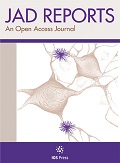Authors: McKay, Mary | Gorai, Sukhamoy | Paidi, Ramesh K. | Mondal, Susanta | Pahan, Kalipada
Article Type:
Research Article
Abstract:
Background: Despite intense investigations, no effective treatment is yet available to reduce plaques and protect memory and learning in patients with Alzheimer’s disease (AD), the most common neurodegenerative disorder. Therefore, it is important to identify a non-toxic, but effective, treatment option for AD. Objective: Cinnamein, a nontoxic compound, is naturally available in Balsam of Peru and Tolu Balsam. We examined whether cinnamein treatment could decrease plaques and improve cognitive functions in 5XFAD mouse model of AD. Methods: We employed in silico analysis, time-resolved fluorescence energy transfer assay, thermal shift assay, primary neuron isolation, western
…blot, immunostaining, immunohistochemistry, Barnes maze, T maze, and open field behavior. Results: Oral administration of cinnamein led to significant reduction in amyloid-β plaque deposits in the brain and protection of spatial learning and memory in 5XFAD mice. Peroxisome proliferator-activated receptor alpha (PPARα), a nuclear hormone receptor, is involved in plaque lowering and increase in hippocampal plasticity. While investigating underlying mechanisms, we found that cinnamein served as a ligand of PPARα. Accordingly, oral cinnamein upregulated the level of PPARα, but not PPARβ, in the hippocampus, and remained unable to decrease plaques from the hippocampus and improve memory and learning in 5XFAD mice lacking PPARα. While A disintegrin and metalloproteinase domain-containing protein 10 (ADAM10) is one of the drivers of nonamyloidogenic pathway, transcription factor EB (TFEB) is considered as the master regulator of autophagy. Cinnamein treatment was found to upregulate both ADAM10 and TFEB in the brain of 5XFAD mice via PPARα. Conclusions: Our results suggest that this balsam component may have therapeutic importance in AD.
Show more
Keywords: ADAM10, Alzheimer’s disease, cinnamein, cognitive function, plaque, PPARα
, TFEB
DOI: 10.3233/ADR-230179
Citation: Journal of Alzheimer's Disease Reports,
vol. 8, no. 1, pp. 903-922, 2024





